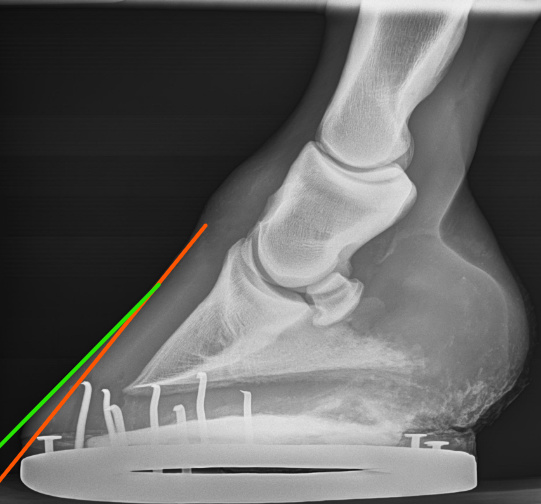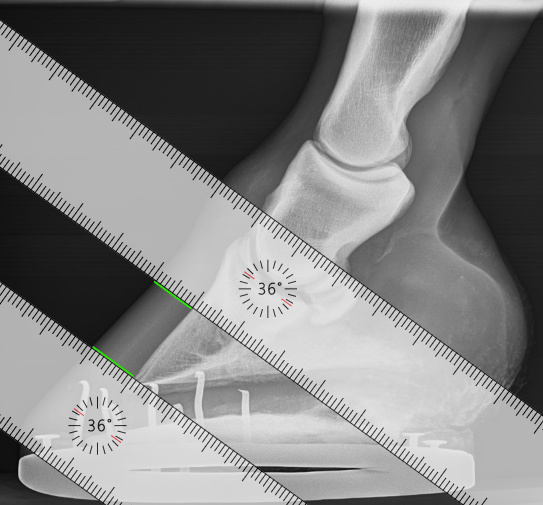The first thing that strikes me on the radiographs is those are some looong nails. Second thing is the rivets - assuming for pads. I have had horses that would be very uncomfortable shod like this. Definitely block first. Then ultrasound - which will probably need to wait a few days after blocking. Then if you need more information MRI. Good Luck!
Peggy thank you for sharing your experiences. Very informative and helpful. My horse does have enlarged neck facets which we keep tabs on as well.
Bonnie - he has rim pads. We thought maybe he didn’t like the feeling of footing on his soles and he hated full pads, so we tried rim pads. He seemed to be happier in them, but there are so many variables it is hard to know what is best. Please tell me more about what might make this shoeing uncomfortable.
@Helicon he was lame on right front only, and we only did the MRI on that leg. Although we did inject both front coffin joints in the end. His only shoeing change was some padding up front to help with concussion. We’re in CA and the ground is especially hard in the summer, so the vet thought the padding may alleviate some of the bursitis.
They didn’t see much benefit in doing PRP or shockwave on his collateral injury for some reason. And honestly after the price of the MRI, I was relieved to hear that. He healed well, but whether or not he holds up long term remains to be seen. Perhaps PRP or shockwave would increase those odds, I’m not sure.
Yes, I would absolutely do the MRI again if it was an expense I could afford given what I learned from this experience… He was so minimally lame at the first onset of the lameness that vets didn’t recommend the MRI, just rest and slowly back to work (which seemed a reasonable approach at the time). But 6 months later after resting and slowly bringing back to full work he went lame again. The MRI showed chronic inflammation at that point that could have possibly been addressed in its acute stage had we done the MRI the first time around. He’s a tough little guy so my guess is once he showed a mild lameness the first time around, the damage was more than it appeared from the outside.
The horse you describe sounds “footy”. You also say he has responded well to prostride in the coffin joints in the past, so that is a known issue. Or it may not be in the feet at all, that’s where blocking comes in. If it is in the foot it could be any number of things or a combination of issues. Rarely simple and that is no doubt why you are considering an MRI. The rim pad is a good idea but the rivets create pressure points. You could try rim pads without the rivets and see if they shift/he is more comfortable. “He hated full pads” - were they packed underneath? Sometimes it is the packing creating sole pressure that is uncomfortable. You could try leather full pads with a couple holes drilled in the center. No packing. They will protect the sole with less pressure. You can hose out any debris that collects. And they dry so you don’t get the damp hoof issues like plastic pads. Medicating the horse and light work for a couple days post shoeing has also helped my sensitive souls ease into their new shoes.
An MRI will show something, perhaps several things. Often they confirm what you already suspect. Sometimes it muddies the waters. Rarely does an MRI offer amazing insight. Whether to pursue an MRI is a question of the ratio of pain to your pocketbook vs your curiosity.
The pads were not packed underneath. That’s interesting about the rivets.
I realize I did not mention something significant- he has quartercracks on the outside of both front feet, presumably because he prefers to land toe first.
The lateral LF view indicates chronically long toes. There’s a shift in the angle of growth about 3/4 up the hoof wall
You can also see how the distance between the face of the wall and the coffin bone increases - 9 lines vs 10
So, IMHO, until that toe is brought back, every single trim, and the straighter new growth line continues to grow down, things won’t get (much) better, and he will continue to land at least a little toe-first
Has anyone (and their vet) used standing on blocks with various parts of the hoof supported where soft tissue concerns in the foot are suspected? Not as diagnostic per se, but as a clue if you are on the right track to spend the $ on the MRI of what not (think very similar to flexions).
I think I first heard it mentioned in some kind of vet webinar and it made a lot of sense. Then in a presentation from a farrier, he said he was using them to do some navicular research and “accidentally” came across some ‘navicular’ horses who were really collateral ligament horses.
Very curious to hear if anyone has tried this.
Personally, I wouldn’t spend money on an MRI until the quartercracks are healed. They bother every horse I’ve seen with one (especially on unlevel ground) and can be a bear to get healed. This may be what is causing the increase in discomfort you are seeing and if not will complicate the diagnosis.
Yes, my vet routinely uses wooden blocks in this way. It was super useful to identify a DDFT injury in one of my horses.
I’ve never heard of this. Can you describe it a little more or do you have a link to what you were talking about? Just trying to learn. Thank you!
I actually found an article about it, that will describe it so much better than I. https://thehorse.com/111213/using-flexion-and-wedge-tests-to-diagnose-foot-pain/
I’ve never seen it done in person, but it makes a ton of logical sense to me.
Thank you Patty / great link and great idea! My farrier did something similar once but I love having the systematic process described.
JB thank you for the feedback. I have been concerned about my horse’s angles but wasn’t sure how to enunciate it, so I appreciate your detailed explanation.
Bonnie - thank you for this advice. I’m going to take it and get to the bottom of these cracks (literally!). This is my first horse to get them in 30 years of horse ownership, so I dont have much experience with them. I was told they weren’t painful unless bleeding, but actually it makes a lot of sense that they hurt. This gives me some hope that it’s not a soft tissue injury at all, although I understand getting quarter cracks under control can be a battle too.
My vet has done the “shim flexions” for my horse and jogged on concrete. He used actual little shims like you see people use to shim window frames, etc. He likes doing that before blocking the heel because the block can flood into the whole foot some.
Quarter cracks on both feet make me think it’s a trimming or shoeing issue. The same horse as above had a quarter crack on the LF that was a lot of trouble to get healed completely and required a trip to the vet school with my farrier to set him up.
I think my horse’s quarter crack was ultimately caused by uneven loading from arthritis developing in his knee. We did not find the knee until it was quite advanced because it was pretty subtle lameness that I could ride him out of until I couldn’t. My advice on blocking is unless the horse is magically perfectly sound to hoof blocks, keep going up the limb(s) just to make sure you find the whole issue.
Amberley - wow thanks for the suggestion. I will definitely order a pair to try. The second part is harder, but I’m working on it.
It may be possible for BoT boots to encourage a little faster growth rate, but that still only helps if the trim is corrected. It only means you might get it grown out a bit more quickly. Without the trim being fixed, nothing else will help.
^^This. If things are out of whack and not being dealt with, more rapid hoof growth is just going to send them further out of whack faster.
Though all the BoT bell boots did for my horse was rub him. And I wasn’t leaving them on 24/7.
Hi! This thread seems to be very informed about hoof related issues… if anyone on here is still active, I’m very anxious about what’s going on with my big guy.
Here’s a link to his case/thread:
TIA 



